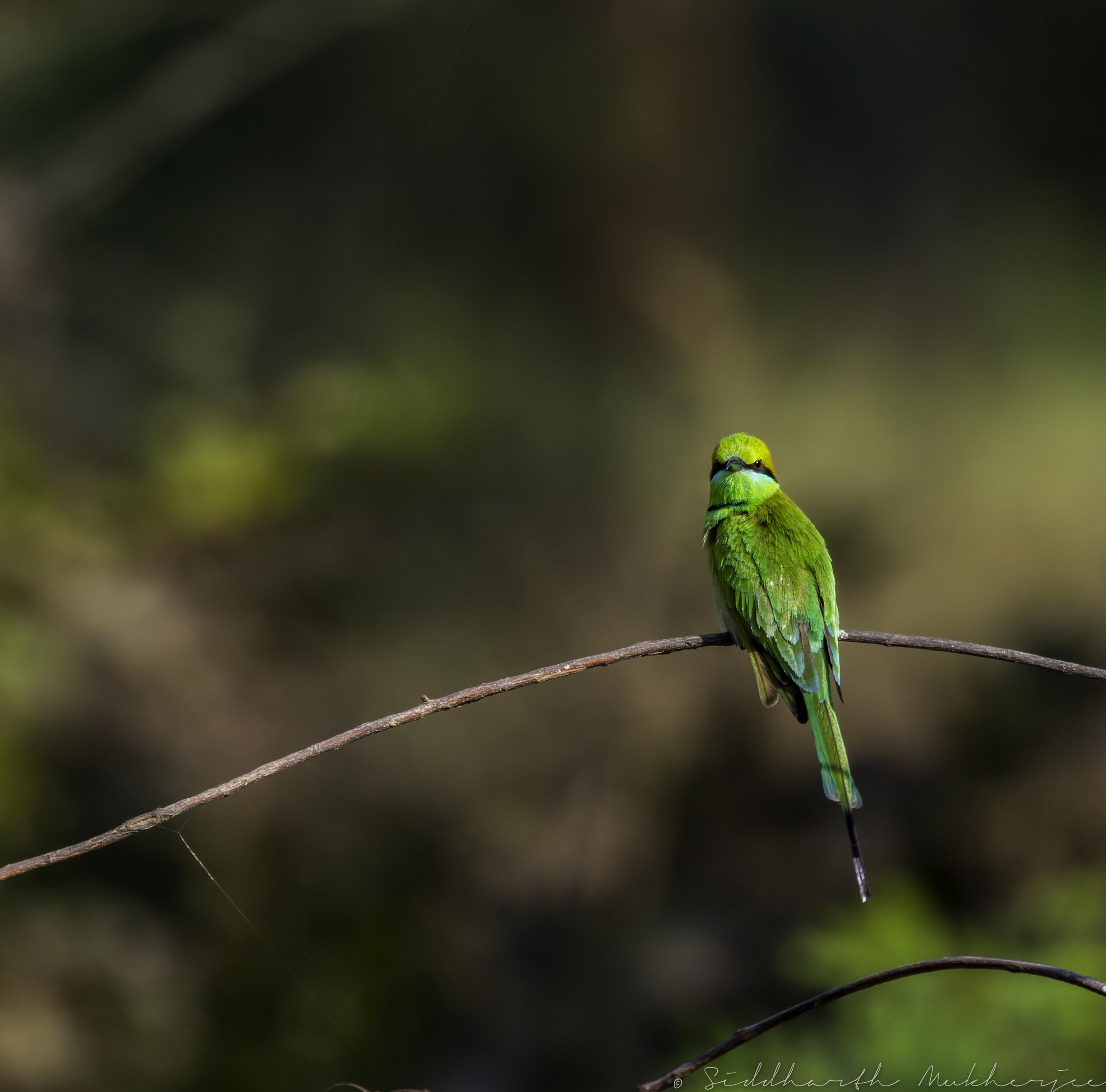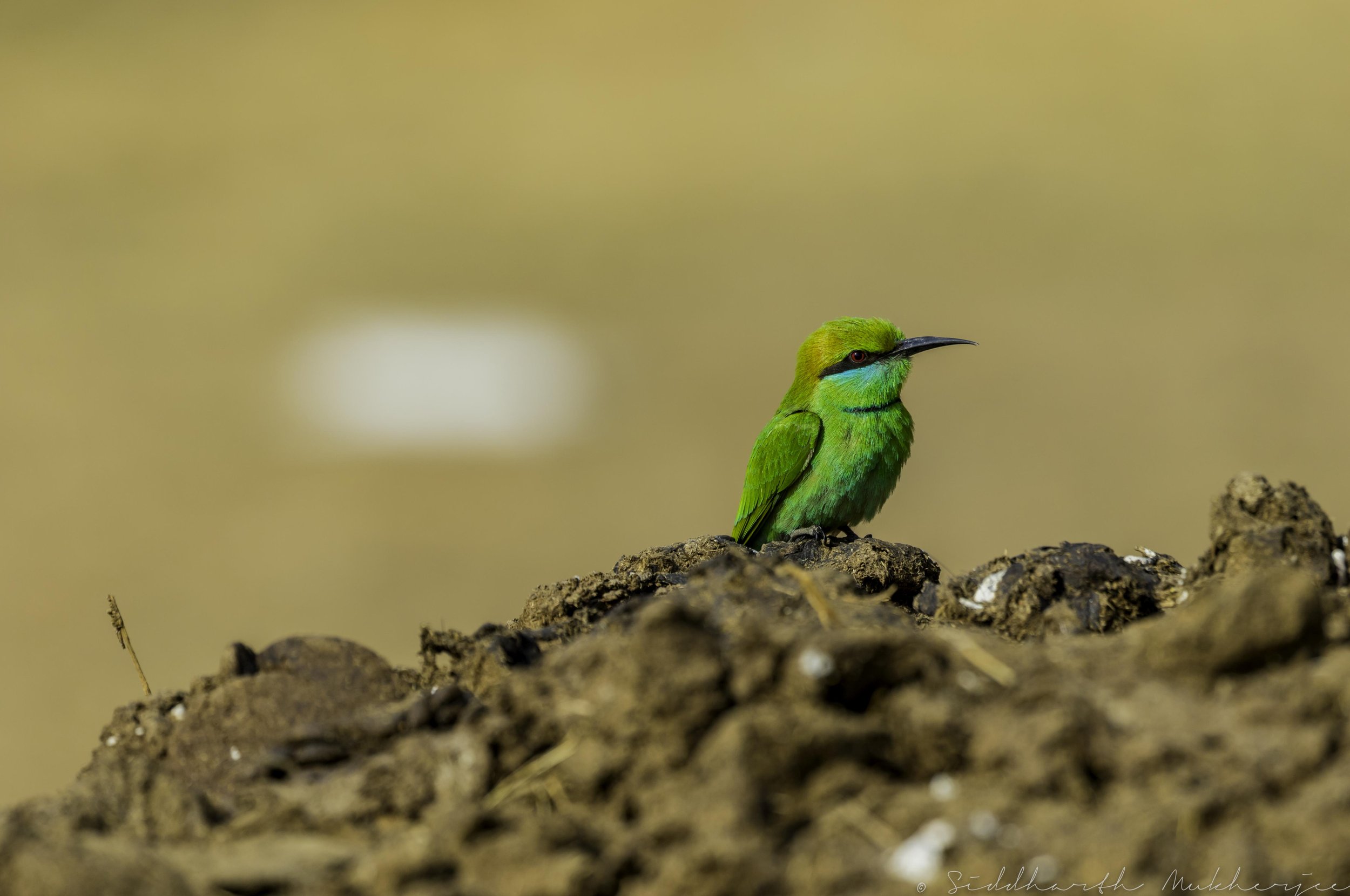Asian Green Bee-eater
Merops orientalis
Nallagandla Lake & Zaheerabad, Telangana
Today we return again to the neighbouring forests of Zaheerabad where I had documented, on an earlier trip, numerous birds and their behaviour. The blog today is about one of them and an often taken for granted bird because it is so commonly seen - the Asian Green Bee-eater. The Asian green bee-eater, also known as little green bee-eater, & green bee-eater in Sri Lanka, is a near passerine bird in the bee-eater family. It is resident but prone to seasonal movements and is found widely distributed across Asia from coastal southern Iran east through the Indian subcontinent to Vietnam.
The Green Bee-eater is a tiny exquisite bird which has bright emerald green plumage. It has a narrow black stripe known as a ‘gorget’ on its throat, and a black ‘mask’ running through its crimson eyes. Its two central, narrow, long black tail streamers are also distinctive, and are only present in mature birds. Male and female birds look the same.
But first about the rural area surrounding the town of Zaheerabad. In general, a rural area or a countryside is a geographic area that is located outside towns and cities. The word rural is defined as encompassing "...all population, housing, and territory not included within an urban area. What ever is not urban is considered rural."
Typical rural areas have a low population densities and small settlements or villages. Agricultural areas too are commonly categorised as rural, as are other types of area such as forests. Different countries have varying definitions of rural for statistical and administrative purposes.
About a 100 kilometers from the capital city of Hyderabad, Zaheerabad is one such industrial town and Municipal Council in the Sangareddy district of the Indian state of Telangana. It is the base for visitors of ancient sacred religious sites like the Ketaki Sangameshwara Swamy Devasthanam (a temple) at Jharasangam, Siddhhi Vinayaka Temple at Rejinthal and Hazrath Multani Baba Dargah (A dargah is a shrine built over the grave of a revered religious figure, often a Sufi saint or dervish) at Metalkunta.
The Zaheerabad area has many diverse areas for birding and in some instances wildlife watching and observation. In close proximity are the Manjeera Wildlife Sanctuary, Gottamgutta, Karanja Reservoir and the Chandrampally Dam and Chincholi Wildlife Sanctuary just over the border in Karnataka. I have had the good fortune to spend a fair bit of time at all these locations and have obtained some beautiful photos with the help of the Forest Officers and Rangers. Read more about some of the birds found near Zaheerabad.
Some of these locations are home to migrants and seasonal visitors and every experience of seeing a new bird provides a rush that one can only feel by doing something they love. As I mentioned in an earlier blog, bird and wildlife watching is a great form of recreation for people of all ages and always provides an opportunity to learn something new.
Small Minivet - Male
Zaheerabad
Being located in the Deccan Plateau in the central stretch, the prosperous state of Telangana has sub-tropical climate & the terrain consists mostly of hills, mountain ranges, and thick dense forests covering an area of 27,292 km². The annual rainfall ranges between 1,100 mm to 1,200 mm and the annual temperature varies from 15 C to 45 C. The state is drained by a number of rivers which include the Godavari and the Krishna.
Telangana is endowed with rich diversity of flora and fauna. It has dense teak forests on the northern part along the banks of river Godavari. As per the Champion & Seth Classification of Forest Types (1968), the forests in Telangana belong to three Forest Type Groups, which are further divided into 12 Forest Types. The State Government has taken up a massive greening programme, 'Telangana Ku Harita Haram' in the State to plant and protect 230 crore seedlings over a period of 4 years. This initiative aims at achieving the twin objectives of increasing the forest cover and reduce pressure on the existing forest resources, through massive community participation by Vana Samrakshna Samithis (VSS) and Eco-Development Committees (EDCs) in Protected Areas and Watershed Development Committees in the Watershed areas. Recorded Forest Area (RFA) in the State is 26,904 km² of which 20,353 km² is Reserved Forest, 5,939 sq km is Protected Forest and 612 km² is Unclassed Forests. In Telangana, during the period 1st January 2015 to 5th February 2019, a total of 9,420 hectares of forest land was diverted for non-forestry purposes under the Forest Conservation Act, 1980 (MoEF & CC, 2019). As per the information received from the State during that last two years, 12,730 ha of plantations including avenue plantations in the State.
Three National Parks and nine Wildlife Sanctuaries constitute the Protected Area network of the State covering 5.08% of its geographical area.
Chincholi Wildlife Sanctuary
The Chincholi Wildlife Sanctuary, declared in 2011, is the first dry land Wildlife Sanctuary in South India. It extends over 134.88 km² along the borders of the southern states of Telangana & Karnataka. The forest is rich in its biodiversity with good dry & moist deciduous forest in the core with Acacia and Teak plantations on the fringes. There are a host of medicinal herbs and trees and species like the Red Sanders and Sandal. The Chandrampalli dam and four smaller dams exist at its Centre. The forest is home to a variety of fauna like the Black Buck, Common Fox, Four-horned Antelope, Fruit bat, Hyena, Indian Wolf etc. Over 35 species of birds, including the Black Drongo, White-bellied Drongo, Black-winged Kite, Blossom–headed Parakeet, Blue pigeon, Black-headed Oriole and Grey partridge call this sanctuary their home.
The Lambani Tandas, a protected tribal community, also make this sanctuary their home living in harmony with nature.
Green Bee-eater
The green bee-eater (Merops orientalis), also known as the little green bee-eater, is a near passerine bird in the bee-eater family. It is resident but prone to seasonal movements and is found widely distributed across sub-Saharan Africa from Senegal & the Gambia to Ethiopia, the Nile valley, western Arabia and Asia through India to Vietnam. They are mainly insect eaters and they are found in grassland, thin scrub and forest often quite far from water. Several regional plumage variations are known and several subspecies have been named. This is an abundant and fairly tame bird, familiar throughout its range. It is a bird which breeds in open country with bushes.
Featured here is the Merops orientalis orientalis found in India and Sri Lanka (has head and neck tinged with rufous). Like other bee-eaters, this species is a richly coloured, slender bird. It is about 9 inches (16–18 cm) long with about 2 inches made up by the elongated central tail-feathers. The sexes are not visually distinguishable. The entire plumage is bright green and tinged with blue especially on the chin and throat. The crown and upper back are tinged with golden rufous. The flight feathers are rufous washed with green and tipped with blackish. A fine black line runs in front of and behind the eye. The iris is crimson and the bill is black while the legs are dark grey. The feet are weak with the three toes joined at the base. Southeast Asian birds have rufous crown & face, & green underparts, whereas Arabian beludschicus has a green crown, blue face and bluish under parts. The wings are green and the beak is black. The elongated tail feathers are absent in juveniles. Sexes are alike. Riverside habitats were found to support high populations in southern India (157 birds per km²) dropping off too 101 per km² in agricultural areas and 43-58 per square km near human habitations.
The call is a nasal trill tree-tree-tree-tree, usually given in flight. These specimen were documented in the wild at various locations in the the state of Telangana. Note the difference in coloration.
The Asian green bee-eater was first described by the English ornithologist John Latham in 1801 using its current binomial name. Several populations have been designated as subspecies:
M. o. beludschicus from Iran to Pakistan (paler colours with a blue throat)
M. o. orientalis in India and Sri Lanka (has head and neck tinged with rufous).
M. o. ferrugeiceps (=birmanus) in northeastern India, Myanmar, Thailand and Vietnam (has rufous crown, mane and mantle).
M. o. ceylonicus in Sri Lanka has the nape and hindneck with more pronounced golden brown sheen often included within the nominate race
The African green bee-eater (M. viridissimus, along with its subspecies M. v. viridissimus, M. v. cleopatra, & M. v. flavoviridis) and Arabian green bee-eater (M. cyanophrys, along with its subspecies M. c. cyanophrys & M. c. muscatensis) were formerly considered conspecific, but were split as distinct species by the IOC in 2021.
A study of species within the genus Merops based on plumage characteristics found that most of the subspecies of M. o. orientalis grouping together with the most similar species being Merops leschenaulti and subspecies M. o. ferrugeiceps appeared closer to that group.
Like other bee-eaters, this species is a richly coloured, slender bird. It is about 9 inches (16–18 cm) long with about 2 inches made up by the elongated central tail-feathers. The sexes are not visually distinguishable. The entire plumage is bright green and tinged with blue especially on the chin and throat. The crown and upper back are tinged with golden rufous. The flight feathers are rufous washed with green and tipped with blackish. A fine black line runs in front of & behind the eye. The iris is crimson and the bill is black while the legs are dark grey. The feet are weak with the three toes joined at the base. Southeast Asian birds have rufous crown and face, and green underparts, whereas Arabian beludschicus has a green crown, blue face and bluish under parts. The wings are green and the beak is black. The elongated tail feathers are absent in juveniles. Sexes are alike.
The calls is a nasal trill tree-tree-tree-tree, usually given in flight.
Leucistic individuals have been noted.
This is an abundant and fairly tame bird, familiar throughout its range. It is a bird which breeds in open country with bushes. In Africa and Arabia it is found in arid areas, but is more diverse in its habitats further east. This species often hunts from low perches, maybe only a metre or less high. It readily makes use of fence wires and electric wires. Unlike some other bee-eaters, they can be found well away from water.
They are mostly seen in the plains but can sometimes be found up to 5000 or 6000 feet in the Himalayas. They are resident in the lowlands of South Asia but some populations move seasonally but the patterns are not clear, moving away to drier regions in the rainy season and to warmer regions in winter. In parts of Pakistan, they are summer visitors.
‡‡‡‡‡
Related Posts





























